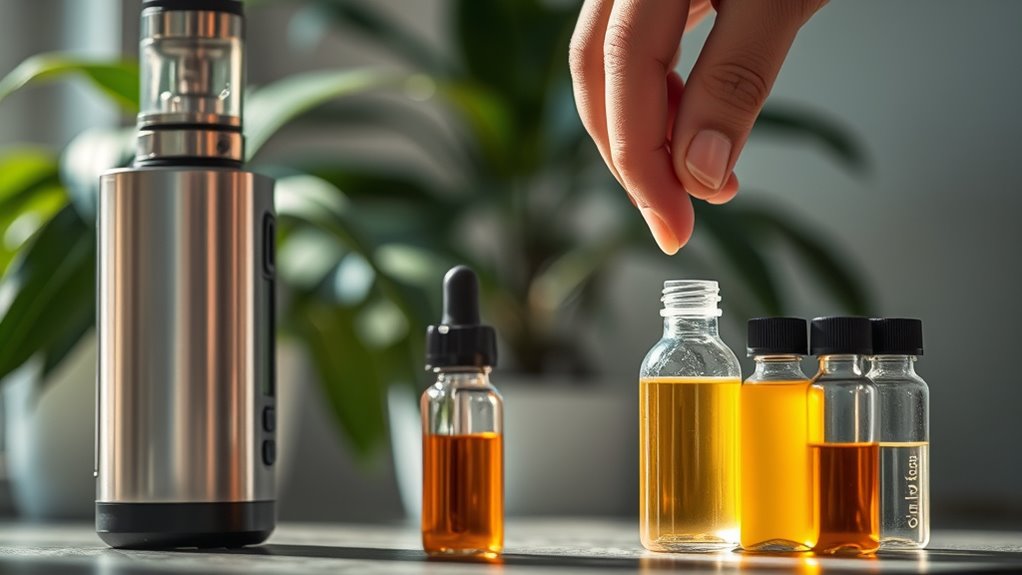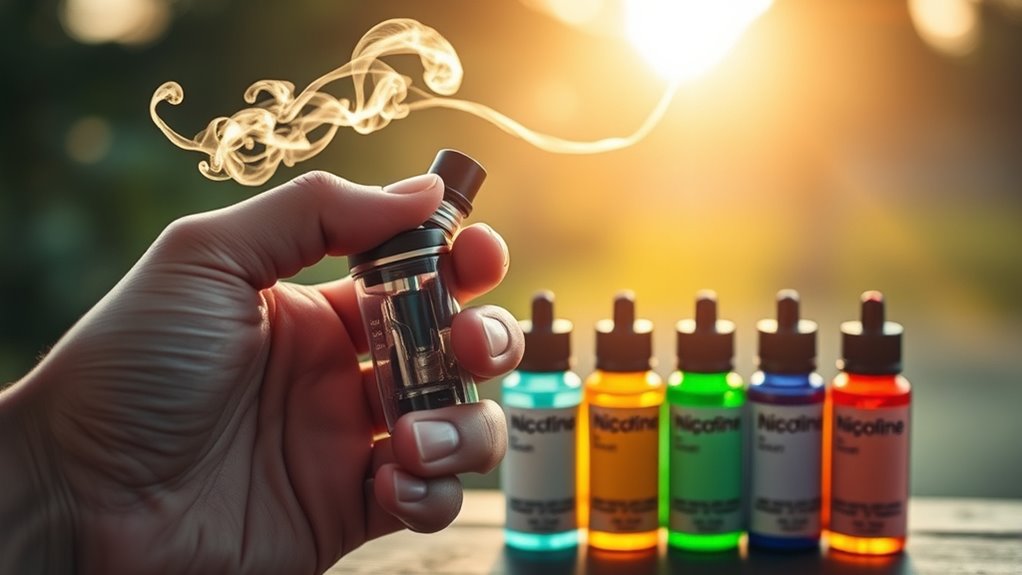To reduce nicotine levels while vaping, start by evaluating your current intake and gradually switch to lower concentration e-liquids. This step-by-step approach helps manage withdrawal symptoms like cravings and irritability. Track your physical and emotional responses, and implement coping strategies like mindfulness or exercise to ease the process. Remember, setbacks are normal, and every small victory counts. Stick with it, and you’ll discover more effective techniques to support your journey to a smoke-free life.
Key Takeaways
- Gradually lower nicotine concentrations in e-liquids to ease the transition while continuing to enjoy vaping.
- Track your emotional and physical responses to adjust your reduction strategy effectively.
- Incorporate mindfulness techniques and physical activity to manage cravings and improve mood.
- Prepare coping mechanisms for high-risk moments, like stress or after meals, to handle cravings.
- Celebrate small victories and stay committed to enhance your overall health and well-being.

Reducing Nicotine Levels
As you consider reducing nicotine levels, it’s essential to understand the impact on your health and well-being. Lowering your nicotine intake can lead to improvements in your overall health, including better lung function and reduced risk of chronic diseases. However, the journey isn’t without its challenges. You may experience nicotine withdrawal symptoms, which can range from irritability and anxiety to cravings and sleep disturbances. Recognizing these symptoms is the first step in successfully steering your reduction journey.
Reducing nicotine levels can enhance your health, but be prepared for withdrawal challenges along the way.
When you decide to step down on your nicotine levels, it’s crucial to approach it systematically. Gradual reduction is often more manageable than quitting abruptly. Start by evaluating your current nicotine intake and choosing a lower concentration e-liquid. This way, you can still enjoy the act of vaping while consuming less nicotine. As you shift, keep track of how you feel—both physically and emotionally. This can help you identify patterns and adjust your strategy as needed.
In addition to tapering nicotine levels, exploring alternative cessation methods can be beneficial. Many people find that incorporating mindfulness techniques, exercise, or even support groups can help alleviate withdrawal symptoms. For instance, engaging in regular physical activity not only distracts you from cravings but also boosts your mood through the release of endorphins. You might even consider talking to a healthcare professional about counseling options, which can provide tailored strategies to manage your withdrawal experience.
It’s also helpful to understand that cravings often peak at certain times, such as after meals or during stressful situations. By anticipating these moments, you can prepare alternative coping mechanisms. Carrying a stress ball, taking deep breaths, or sipping on flavored water can provide a satisfying diversion. Remember, it’s normal to face setbacks, but what matters is how you respond to them. Don’t hesitate to reach out for support when you need it.
As you move through this process, keep in mind that every small victory counts. Reducing your nicotine levels isn’t just about cutting back; it’s about reclaiming control over your health. With patience and perseverance, you can steer the challenges of withdrawal and emerge stronger. By embracing alternative cessation methods and staying committed to your goal, you’ll not only lower nicotine levels but also enhance your overall quality of life. Additionally, you may find that engaging in exercise and mindfulness techniques can significantly support your reduction journey. Stay focused on your journey, and you’ll find that each step brings you closer to a healthier, smoke-free future.
Frequently Asked Questions
What Are the Health Benefits of Reducing Nicotine Levels?
Reducing nicotine levels offers significant health benefits for you. It helps break nicotine dependency, making it easier to regain control over your habits. Lowering your intake can improve lung health, reducing the risk of respiratory issues and enhancing your overall well-being. You might notice better stamina and easier breathing, which can lead to a more active lifestyle. Plus, it can decrease anxiety levels and improve mood, contributing to a healthier mind and body.
Can I Mix Different Nicotine Levels in My Vape?
Yes, you can mix different nicotine levels in your vape. Just make sure the flavors are compatible; some blends might not taste as good when combined. Experimenting with nicotine mixing lets you customize your experience, helping you find the right balance that suits your preferences. Just remember to track the total nicotine content, so you know how much you’re consuming. Enjoy the process of finding your perfect mix!
How Do E-Liquid Flavors Affect Nicotine Absorption?
E-liquid flavors can markedly affect nicotine absorption rates. Sweet or fruity flavors often mask the harshness of nicotine, making you less aware of its strength. This flavor masking can lead you to inhale more deeply or frequently, potentially increasing the overall nicotine you absorb without realizing it. Choosing the right balance of flavors can help you manage your vaping experience, so pay attention to how different tastes interact with your nicotine intake.
Is It Safe to Use Nicotine Patches While Vaping?
It’s generally not safe to use nicotine patches while vaping due to potential nicotine patch interactions. Combining both can lead to excessive nicotine intake, causing side effects like nausea or increased heart rate. If you’re considering this approach, it’s essential to consult with a healthcare professional first. They can provide safety precautions tailored to your situation, ensuring you reduce nicotine levels effectively without compromising your health. Always prioritize your safety when managing nicotine consumption.
What Are Common Withdrawal Symptoms When Reducing Nicotine?
When you reduce nicotine, you might experience common withdrawal symptoms like intense cravings and mood swings. Managing these cravings can be challenging, so it’s important to have coping strategies ready. You may feel irritable or anxious as your body adjusts. Staying active, practicing relaxation techniques, and finding support can help you navigate these symptoms. Remember, it’s a process, and you’re not alone in this journey to a healthier lifestyle.
Conclusion
As you embark on your journey to reduce nicotine levels, remember it’s like gently weaning yourself off a beloved old friend. Take it one step at a time, savoring each moment as you lower your intake. With patience and determination, you’ll find the right balance that suits you. Before you know it, you’ll be soaring free, enjoying the flavors of vaping without the weight of nicotine holding you back. Keep going; you’ve got this!










